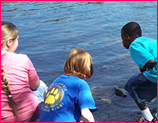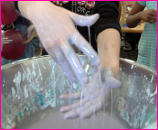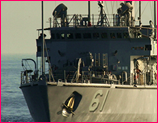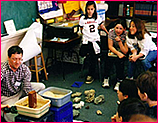Posted on March 6th, 2011 by Mary Lord
 Is America ready to join Europe and Asia in embracing a common curriculum? A bipartisan group of educators, business leaders and labor representatives thinks so. Citing the common English and math standards some 40 states have adopted, the group announced support this week for a proposal to provide specific guidelines for schools and teachers about what should be taught in each grade.
Is America ready to join Europe and Asia in embracing a common curriculum? A bipartisan group of educators, business leaders and labor representatives thinks so. Citing the common English and math standards some 40 states have adopted, the group announced support this week for a proposal to provide specific guidelines for schools and teachers about what should be taught in each grade.
Read More
Filed under: K-12 Education News | Comments Off on Angling For A Common Curriculum
Tags: Curriculum, Education Policy, Public Policy
Posted on March 6th, 2011 by Mary Lord
 From the “miracle fiber” Kevlar invented by Dupont chemist Stephanie Kwolek to Silly Putty, our world abounds with materials discovered by accident. In this activity from the Society of Women Engineers (SWE), students will learn some serious materials science–and hit several national science and tehcnology standards–by using everyday items to create and investigate the properties of Funny Putty.
From the “miracle fiber” Kevlar invented by Dupont chemist Stephanie Kwolek to Silly Putty, our world abounds with materials discovered by accident. In this activity from the Society of Women Engineers (SWE), students will learn some serious materials science–and hit several national science and tehcnology standards–by using everyday items to create and investigate the properties of Funny Putty.
Read More
Filed under: Class Activities, Grades 6-8, Grades 6-8, Grades K-5, Grades K-5, Lesson Plans | 1 Comment »
Tags: Class Activities, Curriculum, Lesson Plan, Lesson Plans, Slime
Posted on March 6th, 2011 by ASEE
 The U.S. Navy now spends $60 million a year on STEM education, but Navy Secretary Ray Mabus wants to double that amount over five years, officials say. The expanded effort is directed particularly at elementary and middle school students in rural and urban communities – not just areas with existing naval facilities – and at university freshmen and sophomores, too many of whom now drop out of science and engineering.
The U.S. Navy now spends $60 million a year on STEM education, but Navy Secretary Ray Mabus wants to double that amount over five years, officials say. The expanded effort is directed particularly at elementary and middle school students in rural and urban communities – not just areas with existing naval facilities – and at university freshmen and sophomores, too many of whom now drop out of science and engineering.
Read More
Filed under: K-12 Education News | Comments Off on Navy on Course to Boost STEM Learning
Tags: Office of Naval Research (ONR), Outreach, Outreach for Schools, STEM education, STEM subjects, U.S. Navy
Posted on March 6th, 2011 by Mary Lord
 Elementary schools are struggling to fit science lessons into a school day packed with other subjects, particularly reading and math that are tied to accountability measures. The amount of science instruction varies by school and district, but many educators say students need more hands-on lessons beginning in elementary school to help prepare them for careers in science fields.
Elementary schools are struggling to fit science lessons into a school day packed with other subjects, particularly reading and math that are tied to accountability measures. The amount of science instruction varies by school and district, but many educators say students need more hands-on lessons beginning in elementary school to help prepare them for careers in science fields.
Read More
Filed under: K-12 Education News | Comments Off on Stuffing Science Into Tight Schedules
Tags: Curriculum, Lesson Plan, Lesson Plans, Teachers
 Is America ready to join Europe and Asia in embracing a common curriculum? A bipartisan group of educators, business leaders and labor representatives thinks so. Citing the common English and math standards some 40 states have adopted, the group announced support this week for a proposal to provide specific guidelines for schools and teachers about what should be taught in each grade.
Is America ready to join Europe and Asia in embracing a common curriculum? A bipartisan group of educators, business leaders and labor representatives thinks so. Citing the common English and math standards some 40 states have adopted, the group announced support this week for a proposal to provide specific guidelines for schools and teachers about what should be taught in each grade.








 From the “miracle fiber” Kevlar invented by Dupont chemist Stephanie Kwolek to Silly Putty, our world abounds with materials discovered by accident. In this activity from the Society of Women Engineers (SWE), students will learn some serious materials science–and hit several national science and tehcnology standards–by using everyday items to create and investigate the properties of Funny Putty.
From the “miracle fiber” Kevlar invented by Dupont chemist Stephanie Kwolek to Silly Putty, our world abounds with materials discovered by accident. In this activity from the Society of Women Engineers (SWE), students will learn some serious materials science–and hit several national science and tehcnology standards–by using everyday items to create and investigate the properties of Funny Putty. The U.S. Navy now spends $60 million a year on STEM education, but Navy Secretary Ray Mabus wants to double that amount over five years, officials say. The expanded effort is directed particularly at elementary and middle school students in rural and urban communities – not just areas with existing naval facilities – and at university freshmen and sophomores, too many of whom now drop out of science and engineering.
The U.S. Navy now spends $60 million a year on STEM education, but Navy Secretary Ray Mabus wants to double that amount over five years, officials say. The expanded effort is directed particularly at elementary and middle school students in rural and urban communities – not just areas with existing naval facilities – and at university freshmen and sophomores, too many of whom now drop out of science and engineering. Elementary schools are struggling to fit science lessons into a school day packed with other subjects, particularly reading and math that are tied to accountability measures. The amount of science instruction varies by school and district, but many educators say students need more hands-on lessons beginning in elementary school to help prepare them for careers in science fields.
Elementary schools are struggling to fit science lessons into a school day packed with other subjects, particularly reading and math that are tied to accountability measures. The amount of science instruction varies by school and district, but many educators say students need more hands-on lessons beginning in elementary school to help prepare them for careers in science fields.